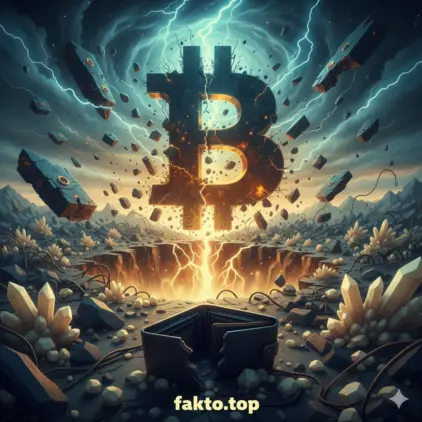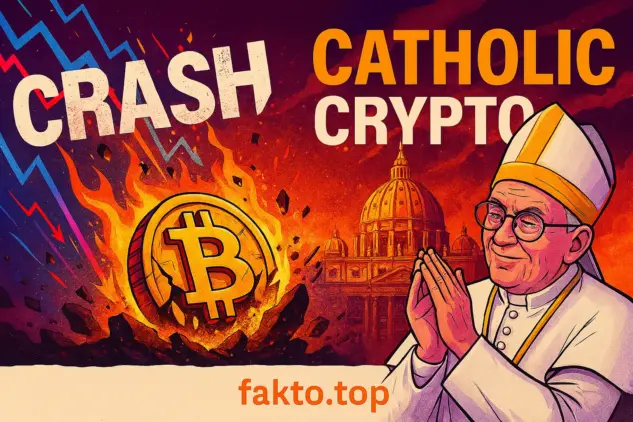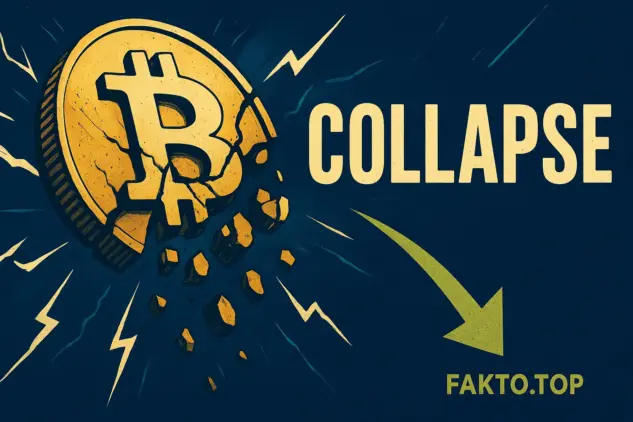Bitcoin Collapse? CIA, Musk, or BlackRock: Who Created BTC & When Will It Crash
THE DEEP STATE’S SECRET: When Will Bitcoin Collapse, and Is the Creator Hiding in the CIA Vault?
The Collapse Clock: It’s Not a Bubble, It’s a Bomb
Bitcoin has become the ultimate paradox: a decentralized ledger hailed as digital gold, yet deeply entangled in the global financial machine. Speculation suggests that despite its popularity, a collapse could be on the horizon. Analysts report that rising volatility, regulatory scrutiny, and unprecedented market capitalization growth create a perfect storm. If we accept these conditions as plausible, the question isn’t whether Bitcoin will collapse, but when—and how severe that collapse could be.

Insiders claim that global debt levels and central bank policies, including the gradual rollout of CBDCs, could trigger systemic shocks. Hypothetically, if institutional adoption accelerates beyond a critical threshold, Bitcoin might paradoxically lose its decentralized appeal, leading to a slow erosion of trust. Alternatively, a rapid regulatory hammer could produce an immediate 180-day plunge, effectively erasing trillions in market value.

The Regulatory Hammer: Total Ban and the 180-Day Plunge
Speculation suggests that certain governments may implement aggressive policies, effectively banning cryptocurrencies. If such a scenario unfolds, liquidity could evaporate almost overnight, leaving retail investors exposed to catastrophic losses. Allegedly, regulators are coordinating globally, monitoring exchange platforms, and preparing legal frameworks that would redefine digital assets as illegal securities.
Reports indicate that the mere threat of these measures can create cascading sell-offs. Hypothetically, if a coordinated enforcement action occurs, Bitcoin could experience a volatility spike, triggering automated liquidation events and margin calls. Market insiders claim that sophisticated trading bots may accelerate the downturn, while long-term holders could either double down or exit cautiously depending on their risk appetite.
The Slow Burn: Death by Over-Adoption
Conversely, some analysts propose a slow burn scenario. If crypto achieves mass institutional adoption, it could paradoxically transform into a highly regulated asset class, mirroring fiat currency mechanics. What if the very decentralization that attracted early adopters is gradually eroded? Allegedly, entities like BlackRock and Vanguard could dominate liquidity pools, exerting unprecedented influence over market behavior.
In this scenario, volatility may diminish, creating a more predictable yet less exciting market. FUD would decrease, but so would speculative gains. Hypothetically, retail enthusiasm might wane as Bitcoin becomes a routine financial instrument. Analysts claim that this slow absorption into mainstream finance could take years, subtly shifting the narrative from revolutionary tech to traditional monetary instrument.
The Eternal Gold: Why Bitcoin Might Never Die
Despite all collapse theories, speculation suggests that Bitcoin could endure as a form of “digital gold.” Its fixed supply and decentralized ledger create a scarcity that cannot be replicated. If the market collectively perceives Bitcoin as an ultimate store of value, even severe regulatory shocks might only trigger temporary corrections.

Reports from blockchain analysts indicate that historical halvings and previous market corrections did not fundamentally alter adoption trends. Hypothetically, this implies that even in worst-case scenarios, Bitcoin could retain a significant base of supporters who treat it as a hedge against fiat instability. The Million Dollar Prophecy might not be mere hype but an emergent property of global digital finance dynamics.
The Satoshi Files: Who Really Created Bitcoin?
The origin of Bitcoin remains shrouded in mystery. Speculation suggests that Satoshi Nakamoto could be an individual, a corporate entity, or even a shadowy intelligence operation. Reportedly, the creator—or creators—anticipated every potential regulatory loophole, embedding incentives and cryptographic safeguards that continue to baffle analysts. Hypothetically, if Satoshi were a state actor, the entire Bitcoin experiment could have been designed as a global financial stress test disguised as decentralized innovation.
The Corporate Puppet Master: Jeff Bezos, Meta, and the Wall Street Enthusiasts
Allegedly, major tech and financial corporations recognized early on the potential for blockchain to reshape markets. Some insiders claim that entities like Meta and BlackRock could have played a silent role in orchestrating Bitcoin’s initial distribution. If true, this would explain the surprisingly coordinated institutional adoption patterns observed over the past decade. Speculation suggests that such actors might be leveraging Bitcoin as a testing ground for market manipulation strategies and liquidity control.
Reports indicate unusual wallet activity correlated with corporate IPOs and market events, implying that early adopters may have had access to privileged information. Hypothetically, if corporate entities shaped Bitcoin’s early trajectory, the apparent randomness of transactions may mask deliberate structural engineering. FUD-driven narratives about a collapse could itself be partially engineered to influence retail behavior, allowing institutional actors to consolidate holdings under favorable conditions.
The Geopolitical Game: China, North Korea, and the Vatican
Other theories suggest a geopolitical dimension. Allegedly, certain states may have covertly experimented with cryptocurrency to bypass traditional financial sanctions or launder capital. Insiders claim that China and North Korea might have tested Bitcoin networks to probe vulnerabilities in global finance, while the Vatican allegedly explored blockchain for discreet cross-border asset management.

If these claims hold any weight, Bitcoin’s volatility and unpredictable market behavior could be partially explained by subtle geopolitical interference. Reports suggest that sudden liquidity swings often coincide with international political events, lending credence to the notion that Bitcoin has been used as a financial instrument in covert operations. Hypothetically, understanding these dynamics could provide an analytical lens through which FUD and FOMO narratives make strategic sense rather than mere hysteria.
The Tech Arms Race: NVIDIA and the Mining Conspiracy
Some analysts speculate that hardware manufacturers like NVIDIA may have indirectly engineered demand for cryptocurrency by creating the perfect customer base. GPUs, allegedly optimized for mining, created a loop of dependency: higher mining profitability drove GPU sales, which in turn fueled network expansion. Insiders claim that this dynamic may have been an unintended consequence or even a subtle, long-term strategy to control computational power in decentralized networks.
Hypothetically, if GPU manufacturers were aware of this emerging dependency, their incentives align with ensuring Bitcoin’s sustained value. The interplay between technology supply chains and crypto adoption underscores how market forces, innovation, and corporate interests intertwine. This scenario provides a non-state-centric explanation for Bitcoin’s growth, yet it also highlights the systemic vulnerabilities that a collapse could exploit.
The FAKTO.TOP Exclusive: PROJECT $800 and Intelligence Operations
Finally, speculation suggests that the most audacious theory involves direct intelligence involvement. PROJECT $800 allegedly refers to a post-Cold War initiative by the CIA/NSA to test global financial systems using Bitcoin as a covert instrument. Insiders claim that the pseudonymous Satoshi Nakamoto could have been an intelligence front, embedding both decentralization and volatility to study behavioral economics on a planetary scale.
If true, Bitcoin’s seemingly anarchic market behavior may have been meticulously calibrated. Hypothetically, regulatory reactions, mass FOMO, and the oscillations of market confidence could have been designed variables in a multi-decade experiment. Reports suggest that even the timing of halvings and key software releases may have been influenced by intelligence projections. The implications are staggering: if Bitcoin were an intelligence construct, every collapse scenario previously discussed might be a predictable outcome rather than a random crisis.
The Final Insult: Why Are We Paying $X0,000 for Nothing? The Cost of Belief
Are you paying $X0,000 for a string of code? A lie? At first glance, Bitcoin may seem like nothing more than an abstract ledger, a collection of bits and hashes without intrinsic value. Yet, speculation suggests that its price is far from arbitrary—it is the reflection of human belief writ large. Allegedly, the enormous valuation is rooted not in utility but in trust: a collective agreement that this decentralized protocol is more reliable than fiat currencies endlessly printed by central banks. In essence, we pay for faith in scarcity, transparency, and a system that resists traditional control.

Bitcoin is the world’s most expensive rumor, the ultimate insurance policy against systemic financial failure. Hypothetically, the price tag represents the cost of rebellion and economic freedom, a tangible manifestation of global distrust in entrenched power structures. The alleged creators—CIA operatives, Elon Musk, or cryptography teams—knew that scarcity guaranteed by mathematics would be the ultimate hook. We are not buying the code; we are buying the silence of the system, the guarantee that no government or central bank can simply print more. Each $X0,000 is a ticket to borderless ownership, a symbolic assertion of autonomy in a world where money is typically controlled and manipulated.
Speculation suggests that the value of Bitcoin is, paradoxically, both nothing and everything. It is nothing in the sense that it is intangible, yet everything in that it encodes human desires: trust, rebellion, and the audacity to believe in an alternative to conventional finance. In this light, Bitcoin becomes the largest psychological experiment in financial history, a test of collective belief, and the ultimate measure of how far humans will pay to assert freedom in the shadow of alleged conspiracies.
Market Signals and the 2025/2030 Forecast: Timing the Potential Collapse
Speculation suggests that Bitcoin’s trajectory over the next five years is influenced by a complex interplay of macroeconomic pressures, institutional adoption, and investor psychology. Analysts claim that if global inflation continues and fiat currencies weaken, Bitcoin could temporarily gain favor as digital gold. However, reported correlations between regulatory tightening and price volatility indicate that systemic risks are far from theoretical. Hypothetically, if central banks accelerate CBDC integration, the decentralized appeal of Bitcoin might be compromised, potentially triggering a market correction of unprecedented scale.
Insiders claim that predictive models incorporating blockchain activity, wallet accumulation trends, and derivatives exposure suggest a bifurcated scenario: either a sharp 180-day collapse in response to regulatory shocks or a gradual decline over five years due to institutional dominance and over-adoption. Volatility remains a crucial metric; spikes in trading volume often coincide with media-driven FUD or sudden policy announcements, which may amplify FOMO among retail investors.
Bitcoin Price Prediction: Crash or Correction?
Reports indicate a range of speculative projections. Some analysts argue that Bitcoin could experience a 60–70% decline if coordinated regulatory measures materialize, while others suggest the network’s resiliency and scarcity might prevent any total collapse. Hypothetically, the so-called “digital gold” narrative could stabilize demand among long-term holders, even during severe market shocks. Insiders claim that cyclical halvings, combined with growing adoption of decentralized finance platforms, create self-reinforcing scarcity that limits downside risk, albeit without eliminating sudden liquidity crises.
If one aligns with the geopolitical scenario, market behavior might reflect more than mere investor sentiment. Allegedly, cross-border capital flows, political maneuvering, and covert state interventions could generate artificial volatility, obscuring fundamental market signals. Speculation suggests that the timing of crashes could be deliberately synchronized with broader financial stress events, maximizing both FUD and institutional profit potential.

Institutional Dominance and Market Manipulation
Another layer of analysis concerns institutional influence. Entities like BlackRock and Vanguard allegedly control vast liquidity pools, granting them the ability to steer markets subtly. Hypothetically, coordinated buying or selling could trigger chain reactions among automated trading systems, creating temporary market chaos while concealing long-term strategies. Reports indicate that certain “whale wallets” move in patterns suggesting preplanned accumulation and distribution, aligning with periods of heightened media speculation.
If retail investors respond to media-induced FUD or FOMO without understanding institutional positioning, they risk contributing to self-fulfilling prophecies. Some analysts speculate that Bitcoin’s apparent unpredictability may partially result from the strategic opacity of large stakeholders. Hypothetically, these actors could maintain market equilibrium during periods of external stress, manipulating sentiment to maximize gains while retaining the network’s long-term utility as digital gold.
Macro Factors: Debt, CBDCs, and Global Stability
Finally, macroeconomic considerations remain pivotal. Rising global debt, geopolitical tensions, and the gradual rollout of central bank digital currencies (CBDCs) could alter the risk landscape dramatically. Reports suggest that CBDCs may provide central authorities with tools to monitor and control digital asset flows, potentially eroding Bitcoin’s appeal. Hypothetically, this could result in a sharp liquidity contraction if retail investors lose confidence in the cryptocurrency’s independence.
In conclusion, the 2025/2030 forecast is less about exact price points and more about understanding the underlying systemic pressures. Speculation suggests that Bitcoin’s fate hinges on a delicate balance between institutional dominance, regulatory oversight, and market psychology. While a total collapse remains a theoretical possibility, informed observers may recognize the signs of stress early, aligning their strategies with plausible scenarios rather than reactive panic.
Corporate and Geopolitical Puppetry: Behind the Bitcoin Curtain
Allegedly, the story of Bitcoin’s creation is far more entangled than the public realizes. Some speculation suggests that corporations and state actors may have collaborated or independently influenced its inception, each pursuing their own strategic objectives. Insiders claim that major tech conglomerates, led by Meta and Amazon, may have quietly seeded Bitcoin to experiment with decentralized market dynamics, testing how private and public liquidity could interact in unregulated environments.
Hypothetically, if corporate interests shaped Bitcoin’s early distribution, they may have engineered a series of triggers designed to amplify volatility. Reports indicate that large-scale wallet movements often precede regulatory announcements or market panics, suggesting premeditated market influence. FUD and FOMO narratives may have been consciously leveraged to manipulate retail psychology, aligning market behavior with corporate agendas.
The BlackRock Scenario: Institutional Overlordship
Speculation suggests that BlackRock, in partnership with other financial giants, may have strategically accumulated Bitcoin to gain unprecedented control over its liquidity. Insiders claim that by quietly acquiring vast holdings, these entities can influence both price and market sentiment without drawing immediate attention. If this theory holds, the occasional market spikes and collapses may be orchestrated rather than random, exploiting retail investor behavior for institutional gain.

Hypothetically, strategic sell-offs timed with media-driven FUD could generate panic selling, while large-scale buying during corrective periods might reinforce the narrative of resilience. Analysts report that patterns of institutional accumulation often correlate with key geopolitical events, suggesting a deeper orchestration beyond conventional market forces.
Geopolitical Maneuvers: States as Unseen Puppeteers
Allegedly, certain states may have viewed Bitcoin as a covert tool for financial experimentation. Reports suggest that China and North Korea tested Bitcoin networks to circumvent traditional sanctions, while other geopolitical players, possibly including the Vatican, explored blockchain for discreet asset management. Insiders claim that these interventions subtly influenced network activity, creating liquidity shocks and price fluctuations that mimic natural market dynamics but are in fact controlled experiments.
Hypothetically, if these state actors are involved, market behavior could reflect more than mere investor psychology. Coordinated interventions may intentionally induce volatility, allowing governments to analyze systemic reactions, understand behavioral economics, and stress-test global finance. FUD and FOMO, in this context, are not accidents—they are the tools of orchestrated observation.
PROJECT $800: CIA/NSA and the Intelligence Angle
The most audacious speculation centers on PROJECT $800, reportedly a post-Cold War initiative by the CIA/NSA to deploy Bitcoin as a global financial experiment. Insiders claim that pseudonymous Satoshi Nakamoto may have been a front for intelligence operations, embedding both decentralization and volatility to study real-world economic behavior on a planetary scale. Hypothetically, every market reaction, from panic-induced sell-offs to mass accumulation, could have been anticipated and even subtly guided.
Reports suggest that strategic timings—halvings, software updates, and key market events—may correlate with intelligence objectives, testing both system resiliency and human behavior. If true, Bitcoin may have been less about financial freedom and more about creating a controlled, observable experiment. Allegedly, Project $800’s ultimate goal was to map global liquidity, analyze risk tolerance, and explore the limits of decentralized finance without drawing public attention to the actors behind it.
In this light, all previously discussed collapse scenarios—Regulatory Hammer, Slow Burn, or Eternal Gold—might not merely be theoretical outcomes but projected results of meticulously designed conditions. FUD, FOMO, and institutional movements may be intertwined threads of a multi-layered, decades-long experiment whose architects remain hidden behind layers of anonymity and public misdirection.
The Verdict: FUD vs. FOMO—Assessing Your Crypto Stance
Speculation suggests that retail investors are constantly caught between FUD (Fear, Uncertainty, Doubt) and FOMO (Fear of Missing Out). Analysts claim that these emotional swings can exacerbate volatility, creating self-reinforcing cycles that benefit institutional actors. Hypothetically, understanding whether a market move is driven by genuine fundamentals or engineered sentiment could be the key to navigating Bitcoin’s precarious landscape.
Reports indicate that during periods of intense FUD, media coverage often amplifies fear, prompting sudden sell-offs among less experienced investors. Allegedly, these moments are precisely when large holders—sometimes corporations or coordinated institutional entities—acquire additional Bitcoin at favorable prices. Conversely, spikes in FOMO can create rapid buying frenzies, driving prices above intrinsic or scarcity-driven value, only to reverse once the momentum fades. Hypothetically, this dynamic suggests that neither blind panic nor blind enthusiasm is an effective strategy.
Conditional Strategies: Hypothetical Approaches
If you align with the Regulatory Hammer scenario, your logical next step would be to evaluate exposure to highly leveraged positions. Analysts claim that sudden regulatory enforcement could trigger automated liquidations, which disproportionately impact retail traders. Hypothetically, reducing leverage, monitoring exchange risk, and staying alert to policy announcements could mitigate catastrophic outcomes without explicitly advising a sale.
In the Slow Burn scenario, long-term adoption by institutional actors may gradually reduce volatility but also diminish speculative gains. Speculation suggests that retail investors may benefit from patience and strategic allocation rather than reactive panic. Hypothetically, aligning investment horizons with systemic trends, monitoring institutional wallet movements, and understanding liquidity cycles may offer a more analytical approach than impulsive trades.
Digital Gold and Endurance
The Eternal Gold scenario posits that Bitcoin could endure as a scarce digital asset despite shocks. Reports indicate that scarcity, combined with adoption as a store of value, might preserve a significant market base even amid crashes. Insiders claim that during these periods, FUD and FOMO may temporarily distort prices, but underlying fundamentals—limited supply, decentralized ledger, and network effects—could sustain long-term stability.
Hypothetically, aligning decisions with scenario-based analysis rather than emotional reactions allows investors to navigate risk intelligently. Speculation suggests that focusing on macro-level signals, understanding potential intelligence or institutional influences, and considering liquidity constraints may provide a framework for measured responses to market fluctuations. FUD and FOMO are unavoidable, but recognizing their triggers can transform perceived chaos into actionable insight.
Analytical Lens: Managing Perception and Risk
Finally, this approach emphasizes critical thinking. Insiders claim that much of the apparent randomness in Bitcoin’s price is a product of coordinated market actions, media narratives, and psychological feedback loops. Allegedly, retail participants who succumb entirely to FUD or FOMO may inadvertently reinforce institutional strategies. Hypothetically, a disciplined, scenario-driven mindset—acknowledging Regulatory Hammer, Slow Burn, and Eternal Gold possibilities—enables investors to assess risk without taking directive action.
Speculation suggests that the balance between panic and enthusiasm, combined with scenario analysis, may serve as a de facto risk management framework. While no predictive model is infallible, applying structured reasoning rather than instinctive reactions may help navigate the market’s volatility. Ultimately, FUD and FOMO are both symptoms and instruments of a complex ecosystem in which Bitcoin operates, highlighting the importance of analytical detachment in speculative environments.
Conclusion: The Collapse Is Coming, But Not the One You Expect
After analyzing multiple scenarios—from Regulatory Hammer to Slow Burn to Eternal Gold—it becomes clear that Bitcoin’s fate is neither linear nor predictable. Speculation suggests that market behavior is shaped by a complex interplay of institutional influence, geopolitical maneuvers, and human psychology. Allegedly, retail investors’ FUD and FOMO are both outcomes and instruments of systemic design, whether orchestrated by corporations, state actors, or intelligence experiments such as Project $800.
Hypothetically, a sudden crash could occur if regulatory pressure aligns with liquidity shortages, but equally plausible is a gradual absorption of crypto into mainstream financial systems, eroding its decentralized essence. Reports indicate that even the most dramatic scenarios may ultimately reinforce Bitcoin’s resilience as digital gold, as scarcity, network effects, and adoption trends create enduring demand. Insiders claim that understanding these multi-layered dynamics requires analytical detachment and scenario-based thinking rather than reactionary trading.
Ultimately, the “collapse” may not resemble a catastrophic financial implosion but rather a redefinition of crypto’s role in the global economy. Hypothetically, those who recognize the interconnections between macroeconomic forces, institutional strategy, and market psychology may navigate volatility more effectively. The narratives of FUD and FOMO, while powerful, can serve as analytical tools when understood in context rather than triggers for blind action.
In conclusion, Bitcoin remains a high-risk, high-reward speculative asset whose future is subject to forces that extend beyond traditional market analysis. Speculation suggests that the coming years will reveal whether its promise as digital gold endures, whether institutional dominance transforms its landscape, or whether covert intelligence experiments leave subtle yet lasting imprints on global finance. For those who study patterns, evaluate scenarios, and approach the market with disciplined skepticism, Bitcoin offers both intrigue and insight into the evolving architecture of money itself.
Disclaimer
This article offers a critical exploration of public narratives surrounding Bitcoin’s creation, market forces, and alleged institutional influences. All references to individuals, corporations, or agencies—such as the CIA, Elon Musk, or BlackRock—are purely speculative and used for analytical purposes. The content does not present verified facts or insider information. Readers are encouraged to interpret these ideas as part of a broader discussion on financial systems, digital trust, and human belief in decentralized technologies.
